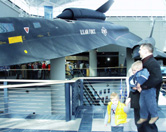 UNMC employees and the public discovered the latest in the application of robotics Saturday at the UNMC Health and Technology Day at the Strategic Air and Space Museum. The event was part of the museum’s Robotic Exhibit.
UNMC employees and the public discovered the latest in the application of robotics Saturday at the UNMC Health and Technology Day at the Strategic Air and Space Museum. The event was part of the museum’s Robotic Exhibit.
As part of the exhibit, several UNMC faculty members talked about and displayed the instruments of computer-assisted, minimally invasive surgery. UNMC College of Nursing faculty and students provided free blood pressure checks and diabetes screenings in its Mobile Nursing Center. Younger and older crowds alike enjoyed the Kids on the Block presentation about cerebral palsy and visual and hearing impairments.
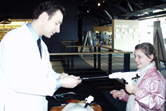 UNMC-related booths offered information on University Medical Associates, the Lifestyle Enhancement Center, the Olson Center for Women’s Health, School of Allied Health Professions, NHS Organ Recovery Services and Cytyc Corp.
UNMC-related booths offered information on University Medical Associates, the Lifestyle Enhancement Center, the Olson Center for Women’s Health, School of Allied Health Professions, NHS Organ Recovery Services and Cytyc Corp.
Participants also were attracted to the museum’s 5,500-square-foot exhibit of 21 hands-on components, designed to educate visitors about the technological advancements, applications and limitations of robotics. Activities include shooting hoops with a seven-foot industrial robot that plays basketball; racing against, building and talking with a robot; and having your portrait drawn by a robotic camera.
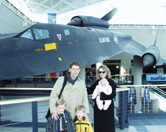 The exhibit was developed by the Carnegie Science Center in Pittsburgh, in collaboration with Carnegie Mellon University and robot manufacturers from around the world.
The exhibit was developed by the Carnegie Science Center in Pittsburgh, in collaboration with Carnegie Mellon University and robot manufacturers from around the world.
Museum visitors who attended presentations by UNMC surgeons were surprised to learn about the choices patients now have for certain surgeries.
“Why don’t we see more laparoscopic and endoscopic surgery being done?” asked one member of the audience.
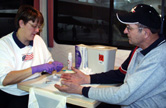 The answer: Not all physicians are willing to change the way they practice medicine, faculty members said. That, too, will change because of patient demand. Thanks to technology, the types of surgeries performed with endoscopic, laparoscopic and robotic equipment and systems is growing, UNMC surgeons said.
The answer: Not all physicians are willing to change the way they practice medicine, faculty members said. That, too, will change because of patient demand. Thanks to technology, the types of surgeries performed with endoscopic, laparoscopic and robotic equipment and systems is growing, UNMC surgeons said.
“With this technology (endoscopy and laparoscopy), we can fix, repair and remove with minimum injury to the patient,” said Dmitry Oleynikov, M.D., UNMC assistant professor of surgery. “The stress to the body is much less.
“The drive for this surgery comes from patients educating themselves and asking for this type of surgery. They found out through the Internet and other resources it could reduce pain and speed up recovery.”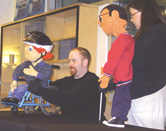
He and Jason Johanning, M.D., said they were attracted to UNMC because of its involvement in minimally invasive surgery and what the technology has to offer patients. Dr. Johanning, an assistant professor of surgery, spoke about minimally invasive and robotic approaches in traditional surgery versus vascular surgery. Instead of making incisions the length of the patient’s leg or longer, surgeons who use newer methods would make several tiny incisions that may not even require traditional stitches.
“Vascular surgery has always been known as the ‘land of the big incisions’ to surgical residents,” he said, speaking of the incisions required of many vascular surgery operations. “We can do only so much with endoscopic surgery. The robot allows us to do the things endoscopic instruments don’t allow.”
In 2000, UNMC became the eighth medical center in the United States to use robotic surgical equipment that allows patients less surgical trauma, shorter hospital stays and faster rehabilitation and recovery.
Dr. Johanning said a patient who undergoes traditional iliac artery surgery usually stays in the hospital five to seven days with six to eight weeks of recovery. The current endovascular intervention, now the first line of treatment, means an overnight stay and three to four days of recovery.
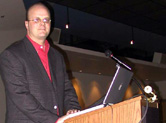 “More than anything, this allows us to offer more choices,” he said.
“More than anything, this allows us to offer more choices,” he said.
Other speakers included Robert Singer, M.D., who explained how minimally invasive techniques are used to treat blood vessel diseases affecting the brain; and Rodney Markin, M.D., Ph.D., who described how robotic technology invented in Nebraska is used in hospitals around the world to transport patient specimens in the lab.
Anyone who purchases a museum membership during the robotics exhibit, which runs through April 28, will be included in a raffle to win two Midwest Express Airline tickets. Membership prices include: family membership, $40; individual, $30; senior, military, educator or student, $25. For more information call 827-3100.
Photo cutlines (in descending order):
- Dan Bozinov and sons, David, left, and Vincent, stop to look at the SR-71 reconnaissance plane. Bozinov, a bioinformatics scientist at UNMC’s Munroe-Meyer Institute, joined approximately 150 other UNMC employees and their families Saturday at the museum.
- Dmitry Oleynikov, M.D., shows a laparoscopic tool to Dylan Powell of Lincoln.
- Jason Johanning, M.D., and his family. From left, to right, sons Connor and Brendan, wife Julie and daughter Molly.
- Sue Trapp, a nurse at UMA Summit Plaza, does a glucose screening on Ron Peterson of Mitchell, S.D.
- Darren Stroupe and Kelley McCormack with Kids on the Block puppets Mark and Renaldo.
- Robert Singer, M.D.